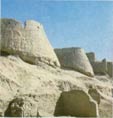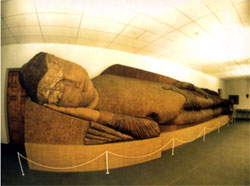

Infoplease Atlas |
| Historically, after the breakup of the
Indo-European family, the Aryan branch subdivided so that the
Medes and the Pars migrated to the Iranian plateau where they
created the Median and Persian Empires respectively; the Sughd
and the Hind migrated to the Aral Sea region. Subsequently, the
Hind migrated southeast and occupied the northwestern regions
of the Indian subcontinent.
Early History  Much,
if not all, of what is today Tajikistan was part of ancient Persia's
Achaemenid Empire (sixth to fourth centuries B.C.), which was
subdued by Alexander the Great in the fourth century B.C. and
then became part of the Greco-Bactrian kingdom, one of the successor
states to Alexander's empire. Much,
if not all, of what is today Tajikistan was part of ancient Persia's
Achaemenid Empire (sixth to fourth centuries B.C.), which was
subdued by Alexander the Great in the fourth century B.C. and
then became part of the Greco-Bactrian kingdom, one of the successor
states to Alexander's empire.The northern part of what is now Tajikistan was part of Soghdiana, a distinct region that intermittently existed as a combination of separate oasis states and sometimes was subject to other states. Sughdiana, settled between 1,000 and 500 BC by Iranian TRIBES, passed into the hands of the Achaemenians who lost it to Alexander the Great in the 4th century BC.Two important cities in what is now northern Tajikistan, Khujand (formerly Leninobod; Russian spelling Leninabad) and Panjakent, as well as Bukhoro (Bukhara) and Samarqand (Samarkand) in contemporary Uzbekistan, were Soghdian in antiquity. As intermediaries on the Silk Route between China and markets to the west and south, the Soghdians imparted religions such as Buddhism, Nestorian Christianity, Zoroastrianism, and Manichaeism, as well as their own alphabet and other knowledge, to peoples along the trade routes. The Arabs conquered Sughdiana in the early 600s. Under Muslim rule, especially with Samanid support, Sughdiana grew to encompass Maymurgh, Qabodian, Kushaniyya, Bukhara, Kish, Nasaf, Samarqand, and Panjekent, each a virtual kingdom. Persian Culture in Central Asia The Persian influence on Central Asia, already prominent before the Islamic conquest, grew even stronger afterward. Under Iran's last pre-Islamic empire, the Sassanian, the Persian language and culture as well as the Zoroastrian religion spread among the peoples of Central Asia, including the ancestors of the modern Tajiks. In the wake of the Islamic conquest, Persian-speakers settled in Central Asia, where they played an active role in public affairs and furthered the spread of the Persian language and culture, their language displacing Eastern Iranian ones. By the twelfth century, Persian had also supplanted Arabic as the written language for most subjects. The Samanids  In
the development of a modern Tajik national identity, the most
important state in Central Asia after the Islamic conquest was
the Persian-speaking Samanid principality (875-999), which came
to rule most of what is now Tajikistan, as well as territory to
the south and west. During their reign, the Samanids supported
the revival of the written Persian language. In
the development of a modern Tajik national identity, the most
important state in Central Asia after the Islamic conquest was
the Persian-speaking Samanid principality (875-999), which came
to rule most of what is now Tajikistan, as well as territory to
the south and west. During their reign, the Samanids supported
the revival of the written Persian language.Early in the Samanid period, Bukhoro(Buchara) became well-known as a center of learning and culture throughout the eastern part of the Persian-speaking world. Samanid literary patronage played an important role in preserving the culture of pre-Islamic Iran. The Tajiks came into prominence as a people under the rule of the Samanids (875-999) who undermined and, to a great degree CENTRALized the government. They also revived the ancient urban centers as Bukhara, Samarqand, Merv, Nishapur, Hirat, Balkh, Khujand, Panjekent, and Holbuq which, in turn, elevated the socio-political, economic and, necessarily, cultural dynamics of the new and progressive Samanid state. Additionally, the Samanids introduced a major program of urbanization, a new civic administration, and a revival of traditional local customs. Furtheremore, the Samanids allocated resources for public education and encouraged innovation and enterprise. In short, they created a civilization that, in many respects, was unique for its time. Samanid revival benefited the sciences, especially mathematics, astronomy, and medicine. Geography, historiography, and philosophy, alongside literature, cultivated the social aspects while mining, zoology, and agriculture contributed to the economy and the well-being of the State. There is hardly anyone in the history of medieval mathematics and the theory of numbers who could rival the fame of al-Khwarazmi, the author of Kitab al-Mukhtasar fi Hisab al-Jabr wa al-Muqabilah. Just a mention of the word "algebra" is sufficient to conjure up the milieu to which al-Biruni, Ibn-i Sina, Sijzi, and Buzjani contributed. Both al-Biruni and Ibn-i Sina were involved in the field of physics as well. The former excelled in the practical aspects of physics while the latter contributed to the theoretical dimensions of the same. The physicist par excellence of the era, however, was Muhammad Zakariyyah al-Razi, the founder of practical physics and the inventor of the special or net weight of matter. Other contributors to physics were Ibn-i Sina (accoustics), Ibn-i Haitham (optics), and al-Biruni (the completion of the efforts of al-Razi in determining special weights). Medicine was the first of the Greek sciences to attract the
attention of Muslim scientists. The history of medicine in the
region, however, dates back to pre-Islamic times when, in AD
529, the Byzantine Emperor Justinian closed the Plato Academy
that had been working under the direction of Precleus. Seven
Roman scientists, who did not have an academy in which to work,
were invited by Khusrau I Anushiravan to Iran to carry out their
research in the newly founded University of Gundishapur. The
forte of the researchers of the University of Gundishapur, which
continued into Islamic times‹until the middle of the ninth century‹was
medicine. During Mongol rule (1219-1370), agricultural development and
urban expansion were halted, local traditions of kingship were
dismissed, and the Shari'a was replaced by the Yasa. Indeed,
the Yasa was used to enforce anti-Muslim policies, discouraging
the Central Asian elite from rebellion against the Chaghatai
khans. Tajiks who could not tolerate the intensity of Mongol
rule either migrated abroad or lived in isolation in the highlands.
The Uzbeks, however, were not the only intruders. Russians, after Muzaffar's defeat in 1868, dominated both the Turks and the Tajiks. Indeed, the Uzbek-Turks served as governors and tax collectors for the Russians. Short after Russian revolution (1917) the Tajik basmachi guerrillas
began a campaign to free the region from Bolshovik rules. It
took four years for Bolshoviks to crush this resistance and
in the process entire villages were razed, mosques destroyed
and great tracts of land waste. But the republic borders inherited from Soviet territorial adminstration are as problematic as the ethnic distinctions inherited from Soviet nationality policy.Republic borders were drawn in Central Asia to divide the population into supposed national homelands according to the Soviet-certified nationalities. No political entity with the current borders of Uzbekistan ever existed before the Soviet period, but the newly written histories of Uzbekistan implicitly project the idea of the present day territory as a coherent whole indefinitely backwards in time, thereby giving it a timeless legitimacy. Between 1929 when Tajikistan SSR centered on Dushanbe came into existence and 1970, Tajikistan underwent intensive Sovietization which, by necessity, accompanied the type of education compatible with carrying out collectivization and industrialization. As was the case in the other republics of the Soviet union, those with nationalistic tendencies were purged. The building of the new socialist republic began in earnest in the early 1930s. In the early stages, a casual observer would not perceive the change immediately. Much of ancient Bukhara continued to resist change. Besides, many peasants preferred the plow to the tractor and many others advocated a return to the old ways. Their numbers, however, were decreasing as were the numbers of their donkeys, mules, and carts that carried the fruits of their labor to the town and city markets. By the early 1930's, there was no question in anyone's mind
that Tajikistan was on the way to becoming a modern republic
with a growing industrial base in the north and a burgeoning
agricultural enterprise in the south. The record of production
of devoted Tajik workers, driven by ideology, confirms this
view. |
Copyright © 2004-2012 PAMIR TRAVEL
Made by: MabigaTeam